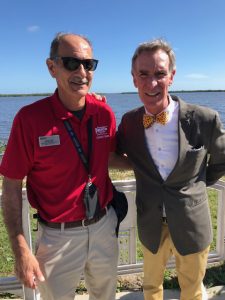Learn more about degree programs at American Public University. |
By Susan Hoffman
Contributor, Online Learning Tips
Charlie Venuto is a part-time professor of environmental science in the Science, Technology, Engineering and Mathematics (STEM) School at APUS. In addition, Charlie is the Director of Environmental, Health and Safety Programs at Delaware North Companies in the Kennedy Space Center Visitors’ Center in Kennedy Space Center, Florida.
In a recent interview, Charlie provided insights on his environmental work. He also shared the story of his APUS research grants and how he used them to highlight the work of Allan and Helen Cruickshank, influential figures in the environmental movement.
What inspired you to enter the field of environmental science?
I was raised in Niagara Falls, New York. When I was growing up during the late 1970s, I heard about the Love Canal pollution disaster, which wasn’t far away from me. Hundreds of families moved out of the area. That event inspired me to learn about environmental science.
In addition, I developed a love of the outdoors because my grandfather loved the Appalachians. We would often go on hunting and hiking trips. He also loved to plant trees for future generations to enjoy.
How did you get your job working in the Kennedy Space Center?

I was taking a graduate class in college. My teacher worked at the Kennedy Space Center and told me that there was a job there. I started in 1981 and I’ve been here ever since. The Visitors’ Center is part museum and part park, and I love to watch launches when they occur.
Tell us about your research project involving the Cruickshanks and their impact on the environmental movement.
Allan Cruickshank was a National Audubon Society photographer, scientist, lecturer and author who published several books and field guides with his wife, Helen. They moved to Florida in 1952.
He taught around the United States and Canada about birds and wildlife. Allan sought to educate people and build a foundation for them to protect the environment and appreciate conservation. Allan transformed bird and nature watching from a fringe interest to a popular national pastime.
Allan would tell people, “I’m here to teach, not preach.” The work by Allan and Helen would eventually serve a part of the foundation for the modern-day environmental movement.
In 2011, I began a research project celebrating the semicentennial of the Merritt Island National Wildlife Refuge in this area. The Kennedy Space Center is actually located in the middle of the refuge. This is a unique juxtaposition of technology and nature. I also received a grant from APUS to investigate how Allan’s work and the Kennedy administration’s devotion to conservation influenced the creation of the Merritt Island National Wildlife Refuge.
During 2015, I received another APUS grant. It allowed me to visit the Roger Tory Peterson Institute in Jamestown, New York, as well as the University of Florida National History Museum archives. I found correspondence between Roger Peterson and the Cruickshanks, as well as personal diaries kept by Allan and Helen. There was also a film documenting the first National Audubon Society Christmas Bird Count at Merritt Island, which was an exciting find.
NASA uses about 7,000 acres for space operations and the other 130,000 acres serve as a buffer in the event of an unplanned rocket event. Allan worked with NASA and the U.S. Fish and Wildlife Service to preserve the unused land. That land became the Merritt Island National Wildlife Refuge.
What has been your biggest professional challenge?
My biggest professional challenge has been to develop the right kind of policies and procedures to ensure compliance with environmental regulations. A cultural change is needed – people need to change their behavior and reduce their carbon footprint.
We’re always seeking improvements. For example, we recently purchased a digester for food waste to reduce the need for that waste to go to a landfill.
What advice would you give to someone looking to get into environmental science as a career?
I would advise anyone who seeks a career in environmental science to get the proper degree. Classes such as chemistry and physics may not be fun, but they are important in this field.
There are various career options in environmental science. You can look for a desk job or a field job. You also have to love to be outdoors and appreciate nature.
What branches of environmental science do you feel have the best opportunities?
Currently, compliance offers the most career opportunities. Sustainability is important to many big organizations and there are also international jobs available.

Comments are closed.